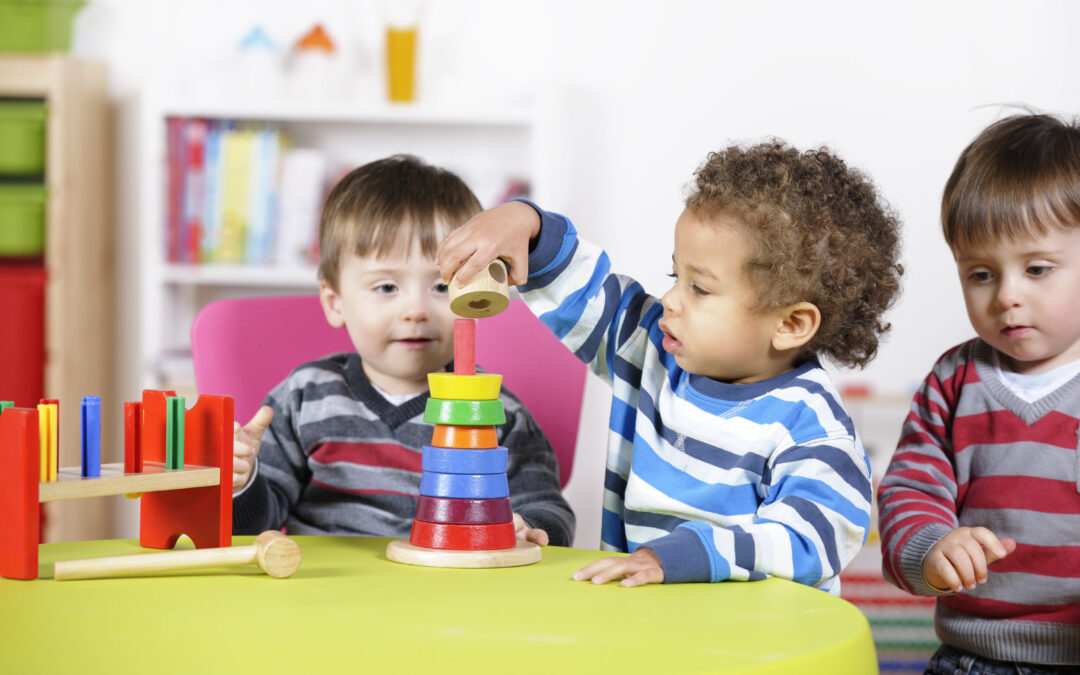Play is the most valuable experience young children have for academic learning! Symbolic thinking, problem solving, persistence, organizing information, connecting ideas, creativity, following social rules, and having a strong sense of self are the foundation for all learning and all present in play.
What is play-based learning for infants and toddlers?
“Play-based” learning is not a new idea. When children explore their environment, experiment, and interact with toys and objects, they are learning. When teachers join them in their play and guide them gently through warm and positive interactions, children are empowered to continue exploring and learning. Observing infants and toddlers as they play and interact with toys also provides an excellent opportunity for teachers to naturally assess their skill progressions.
As leaders, it is important to foster an environment where teachers feel confident supporting this play-based learning. Below, we look at some things you may wish to share with teachers to help them support play-based learning with the youngest learners.
Supporting Young Infants With Play-Based Learning
Very young infants are much more interested in watching faces, hearing voices, and being held than “playing” in the traditional sense. Once they can focus on objects and hold toys in their fists, however, they are ready to respond to toys and other objects that teachers may provide.
Select toys and materials carefully for this age group. Not only must all items that infants use be safe and easily sanitized, but they should also gently challenge children’s developing abilities and skills. Encourage children to use their senses; explore shapes, colors, and sizes; strengthen their muscles; experiment with cause and effect; and explore books and writing. Open-ended materials like blocks, balls, or stacking toys can be used in many ways, and they encourage children to explore and experiment.
Because young infants are learning about the world around them, materials in the classroom should also reflect the children’s lives. Culturally relevant materials and decorations that create a home-like environment, for example, can ease children’s transition from home to school. Family photos and books that feature characters that look and sound like family members all help create a connection to the most important place in a young child’s life: their home.
While observing children engaged in daily care routines and experiences, here are the kinds of things teachers may say or do as they play with a young infant.
- Describe the experience: There’s Kayla, in the mirror. Look, there she is!
- Verbalize feelings: That surprised you, didn’t it?
- Play with language: Peek-a-boo. I see you. Peek-a, peek-a-BOO!
- Describe actions: You are holding your little feet. Your sock came off! Look at those sweet toes.
As infants explore and interact, these experiences provide important data points for teachers. How does each child react to a caregiver’s actions? When teachers and caregivers observe these subtle cues, they are collecting information about the child’s development and learning. Not only is this helpful for formative assessment, but it also helps to inform and guide how teachers and caregivers support and individualize their interactions with each child.
Supporting Older Infants With Play-Based Learning
Once infants are mobile, they seem to be in love with the world and fascinated by everything in it. Filling and dumping are favorite activities of this age group, and any container and object(s) will work. Children this age also enjoy tossing things, so offer them plenty of space and soft, unbreakable toys.
When we observe children tossing, filling, or dumping toys, we are watching them demonstrate their growing physical, social–emotional, and cognitive skills. They can grab the toy they want and toss it, chew it, or do anything with it they wish. They have control over their actions like never before. They love having the power to dump toys out of a container, which means they have to put them back in the container before they can dump them out again. This cycle of filling and dumping shows their persistence, their exploration of cause and effect, and their interest in solving their own problems.
Here is what a teacher might say and do while playing with an older infant:
- Describe what the child does and what happens (cause and effect): Look what happened when you pushed the button. The bear popped out!
- Encourage the child to solve problems: Uh-oh, the ball rolled under the table! How can you get it?
- Build vocabulary by using descriptive words: You decided to play with the red fire truck. It’s the same color as your red shirt.
- Promote a recognition of group needs: You put all of the blocks back in the bucket where we keep them. That was a big job, so you and Drew did it together.
Teachers and caregivers can support these newfound abilities by offering a variety of opportunities for open exploration. As teachers observe, they are gathering important data for assessment and deciding how best to plan experiences that build off each child’s interests and skills. For example, if the teacher observes that a child is drawn to stacking large foam blocks, they may consider offering smaller, less sturdy blocks for a bit of a challenge. How will the child adjust their actions to stack these blocks? As teachers watch, they become able to constantly modify the activities to meet and gently challenge a child’s skills and abilities.
Supporting Toddlers With Play-Based Learning
Toddlers use toys with increasing intention. As they play, they build their physical and language skills, learn concepts, apply thinking skills, explore the world of social roles and make-believe, and learn to be a member of a group.
Toddlers are often excited to act out familiar scenarios. Imaginative play is a huge leap in their cognitive and language development! They can visualize, plan, and create play scenarios from their lives. Teachers should offer familiar materials to encourage this pretend play, such as hats, purses, sunglasses, easy-to-pull-on clothes, toy food, plates, cups, baby dolls, and play phones. Encourage teachers to invite families to share ideas or items that reflect their home and culture. As children see their lives reflected in the classroom and act out scenarios with other children, they are playfully using language, cognitive skills, and social–emotional skills.
When observing toddlers playing, teachers and caregivers might notice children taking on more self-help skills independently. They may struggle to put on an art smock, but resist any helpful intervention. This is an important sign of their social–emotional need to assert their independence. However, if they grow frustrated, they may demonstrate an emerging ability to manage their strong emotions. Being a toddler can be difficult. They can suddenly do so much, but they will still need a lot of help and encouragement from the adults they trust.
- To promote physical skills: I see that you are using your big muscles today. Thank you for helping me carry these big blocks over to the carpet.
- To support symbolic thinking skills: Can you find the picture on the box that matches the animal blocks?
- To encourage perseverance: It’s hard to get that puzzle piece to fit. Why don’t you turn it around and see if it fits then? I bet you can get it to fit.
- To promote a recognition of the needs of others: You are waiting patiently for your turn with the baby doll stroller.
Learning through play comes naturally. When young children play with toys, they are exposed to important ideas and concepts and are presented with authentic opportunities to develop important knowledge, skills, and abilities. And along the way, both children and the adults who care for them can laugh together and have a lot of fun.

